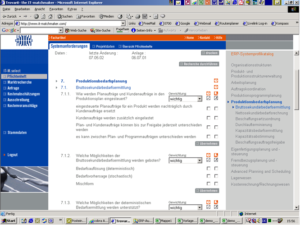ERP implementation in SMEs
Industry-specific add-ons create additional functions – projects cost less than a third of a new implementation
by Götz Andreas Kemmner
When business processes change in a company, there is often a call for new standard software. An alternative to this can be reconfiguring the existing system or upgrading its functions using add-on tools.
The conversion of company-wide standard software (ERP) must follow a structured procedure, just like the initial implementation. The first step is to compare the actual and target requirements. The majority of the requirements should be derived from the organizational processes that were ideally documented during the initial selection. Unclear organizational processes lead to incorrect requirements and thus to inappropriate ERP systems, which in turn cement the wrong organization.

The process analysis lays the foundations
A comparison of two North Rhine-Westphalian automotive suppliers shows just how important it is to analyze business processes. Both competitors manufacture comparable products with approximately the same size and around 600 employees. While in one company the organizational processes were specifically simplified and supported by the ERP system used, the second manufacturer tried to replicate the established processes in the system. This resulted in additional annual costs of 500,000 euros, as benchmarking later showed. Conclusion: The digitalization of processes in the ERP system can only ensure the productivity gain that the preceding optimization of organizational processes has generated.
Even if the second company was not prepared to specifically simplify its own business processes, it would have been better to at least adapt the organization to the specifications of the ERP system. The customized solution turned out to be a waste of money.
The second step is to decide whether a reconfiguration or upgrading with add-ons is sufficient or whether a new implementation is necessary. Due to the large number of systems on the market, a database-supported approach is recommended, such as Trovarit(www.matchmaker.de; unfortunately now offline [2019]) or Softselect (
www.softselect.de
) offer. However, because a large number of criteria are stored in the databases, such selection procedures become quite complex and are best suited to companies that know exactly what they want. Both providers therefore recommend the accompanying use of consultants. If the existing ERP system passes the comparison test, it still has development potential: either through customer-specific customization or through add-on tools from third-party providers. As a rule of thumb, a reconfiguration only costs a third of the selection and introduction. Add-ons are even cheaper.
System expansion via add-on modules is often the first choice, not only for cost reasons, but also because the add-ons contain in-depth industry expertise. One example of this is the Diskover scheduling software, which is based on many standard ERP systems. One of the pilot users is the writing instrument manufacturer Montblanc. In addition to SAP, it has been running there for a good 15 months in the writing instruments and leather goods product areas. With great success: delivery readiness was significantly increased and, at the same time, work in progress was reduced. Other product areas will soon follow suit.
But even without the functional expansion via add-ons, the conversion of an ERP system can pay off, as the example of Orthomol, a manufacturer of medical nutritional supplements, shows: The company had complained about unacceptable problems with support for purchasing, a lack of production planning and control and inadequate support for materials planning. Following a target/actual comparison of the existing functionalities and the unfulfilled requirements, consultants determined that a system conversion was the most economically viable option and began the reconfiguration in 2000. With its now very efficient ERP system, Orthomol was able to triple its turnover.

